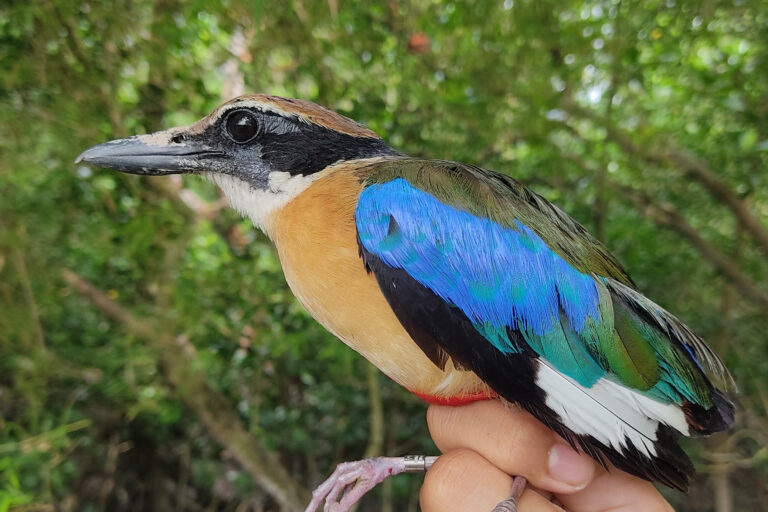- Mangrove restoration is often motivated by the desire to bring back biodiversity to degraded coastlines, but it’s difficult to know exactly when that objective has been achieved.
- Researchers in Malaysia say that monitoring mangrove-dwelling bird communities using bioacoustics could be a game-changer for managers tracking mangrove ecosystem recovery.
- Bioacoustics, the use of audio recording devices to listen to animals in their natural habitats, is increasingly being used as a rapid and relatively cost-effective way of measuring ecosystem health.
- The new study found bird species richness increases across a range of mangrove forest characteristics, including greater canopy cover, tree height and ground cover, indicating birds could serve as useful indicators of mangrove health.
The soundscape in mangrove forests can be wonderfully complex. If you prime your ears, you might chance to hear mudskippers sloshing their bellies across silky mud, or fiddler crabs pattering between their burrows. If you’re lucky, a rustling overhead might indicate monkeys creeping along branches, intently curious, or it could be a Brahminy kite taking off, soaring back out to hunt at sea. But a sound you’re sure to hear is birdsong.
Researchers in Peninsular Malaysia recently used this coastal avian chorus to study how bird species richness varies according to several mangrove habitat characteristics.
They found that mangrove forests with older, larger and taller trees, and with greater canopy cover and understory complexity, supported a wider variety of species. Mangrove specialist birds are particularly more likely to be found in these larger, more mature sites, according to the findings, published in the journal Biotropica.
“When the habitat itself is structurally very complex, we expect more species to be able to fit into it by occupying what we call ecological niches,” study co-author Chong Leong Puan, a forestry scientist at the University of Putra Malaysia (UPM), told Mongabay. “So conserving large and old areas of mangrove is absolutely critical.”

Puan and his colleagues used bioacoustics — the use of audio recording devices to listen to animals in their natural habitats — to study the bird communities at four mangrove forest reserves in Selangor state on the southwest coast of Peninsular Malaysia. Each reserve was in a different stage of restoration; the youngest patches of habitat were roughly 10 years old, whereas the oldest had been planted more than four decades ago.
They set up 20 automated audio recorders across the habitats and used acoustic software and local bird experts to decipher the calls and songs. They then analyzed the relationship between birds and a variety of habitat variables assessed via field surveys.
In total, they identified 53 bird species, including two species classified as near threatened on the IUCN Red List — the olive-backed woodpecker (Chloropicoides rafflesii) and the mangrove pitta (Pitta megarhyncha) — as well as several owls and other birds of prey. The largest and most mature site, Kuala Selangor Nature Park, supported by far the most bird species, while the smallest site, Banjar Utara Forest Reserve, had the least.
The team say their findings indicate that birds are useful benchmarks of mangrove ecosystem health and suggest that monitoring mangrove-dwelling bird communities using bioacoustics could be a simple and cost-effective way for land managers to track the progress of mangrove restoration projects.
“We often plant mangroves, but we don’t necessarily know at what stage we’ve achieved what we set out to do in terms of bringing back biodiverse wildlife communities,” Puan said. “Studying birds using bioacoustics is an alternative and rapid way of getting answers to these questions.”

Protection and restoration
Loo Yen Yi, a bioacoustics research fellow at Sunway University in Malaysia, who wasn’t involved in the study, said the findings reaffirm what makes birds good indicators of mangrove health. “Many birds are highly mobile and respond almost immediately to habitat changes,” she said. They’re also often specialists too, she added, requiring very specific types of food in their habitat.
Loo agreed that monitoring bird communities using bioacoustics has clear potential for tracking the long-term progress of mangrove restoration. She said bioacoustics is increasingly used in Southeast Asia, where it allows bird researchers to gather long-term and in-depth data from dense forests that would otherwise be impractical to survey on foot. “[Bioacoustics] also minimizes the effect of the presence of human observers on birds’ vocal activity, which increases the chance of detecting rare and endangered species,” she added.
The habitat characteristics that positively influenced the number of bird species during the study were: increasing canopy cover, average tree height, forest age and size, number of saplings, and ground cover complexity.
The authors call on forest managers to consider these habitat variables when they plan restoration programs, taking into account how the tree species they opt to plant might affect the eventual biodiversity outcomes of the project. Optimizing planting to achieve good canopy cover, height and forest complexity, for instance, could potentially maximize the benefits for biodiversity, ecological resilience and overall ecosystem health, they say.

However, Puan said it’s important to recognize that selecting the most suitable mangrove species for a given site will depend on many additional factors beyond whether or not it’s good for biodiversity. Mangrove ecosystems are governed by a process of natural succession, he said, whereby tree species naturally outcompete and replace each other as the forest grows and develops.
These complex biological and physical coastal interactions are all the more reason to conserve large areas of existing mangrove, according to Puan. Larger blocks of mangrove often span a variety of habitats, all the way from mudflats and intertidal zones to dense forest. This mix of habitats inevitably provides a wider variety of shelter, food sources and nesting options for birds and other wildlife, he said.
In Southeast Asia, such expansive mangrove areas are crucial stopover sites for birds migrating along the East Asia-Australasian Flyway, the study notes.
A vital next step for conservation efforts, therefore, will be connecting up these larger patches of mangrove by restoring and protecting coastal habitat corridors. “Understanding how these ecosystems can be effectively linked and restored in a way that supports the movement of bird species is essential for their long-term survival and health,” the study says.
“We should be doing replanting, and allowing those areas to grow to the stage that we want for biodiversity,” Puan said. “And then we should also be protecting those areas that already have all the habitat features we want — the large, old, mature mangroves.”
Carolyn Cowan is a staff writer for Mongabay.
Citations:
Rahim, A. H., Puan, C. L., Mah, A. N., Zakaria, M., Jamaludin, N., & Wahaf, N. S. (2025). Bioacoustic assessment of mangrove health: Influence of habitat characteristics on bird richness. Biotropica, 57(1). doi:10.1111/btp.13427
Related audio from Mongabay’s podcast: An audio journey through bioacoustics research, featuring a number of recordings of wildlife, from owls, lemurs, and elephants to seals, right whales, and humpbacks, listen here:
See related story:
With fewer birds seen on farms, scientists try listening for them
FEEDBACK: Use this form to send a message to the author of this post. If you want to post a public comment, you can do that at the bottom of the page.








